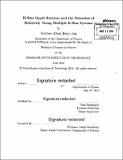K-Star rapid rotators and the detection of relatively young multiple K-Star systems
Author(s)
Joss, Matthew Albert Henry
DownloadFull printable version (5.176Mb)
Other Contributors
Massachusetts Institute of Technology. Department of Physics.
Advisor
Saul Rappaport.
Terms of use
Metadata
Show full item recordAbstract
In this thesis, I searched through the Kepler light curves of 14,440 K-star targets for evidence of periodicities that indicate rapid stellar rotation. Many Kepler M, K, and G stars show modulations in flux due to rotating star spots, and these have been previously investigated by a number of different groups. Rotational periodicities mediated by the rotation of stellar spots were identified using Fourier transforms of Kepler light curves. Additional analytical techniques including the folding of light curves and the utilization of 'sonograms' were used to support our hypothesis that these periodicities arise from the rotation of stellar spots as opposed to planetary transits, binary eclipses, or stellar pulsations. In total, 293 of the Kepler K-star targets exhibited rotational periods, Prot, of 2 days or less. Of these 293 targets, 17 systems show two or more independent short periods within the same photometric aperture. Images from the United Kingdom Infra Red Telescope (UKIRT) provide evidence for my conclusion that these 17 targets with multiple periods are likely to be relatively young binary and triple K-star systems. The ~ 2% occurrence rate of rapid rotation among the 14,440 K star targets is consistent with spin evolution models that presume an initial contraction phase followed by spin down due to magnetic braking where typical K stars would be expected to spend up to a few hundred million years before slowing down to a rotation period of more than 2 days.
Description
Thesis: S.B. in Physics and Earth, Atmospheric, and Planetary Sciences, Massachusetts Institute of Technology, Department of Physics, 2014. Cataloged from PDF version of thesis. Includes bibliographical references (pages 55-56).
Date issued
2014Department
Massachusetts Institute of Technology. Department of PhysicsPublisher
Massachusetts Institute of Technology
Keywords
Earth, Atmospheric, and Planetary Sciences.